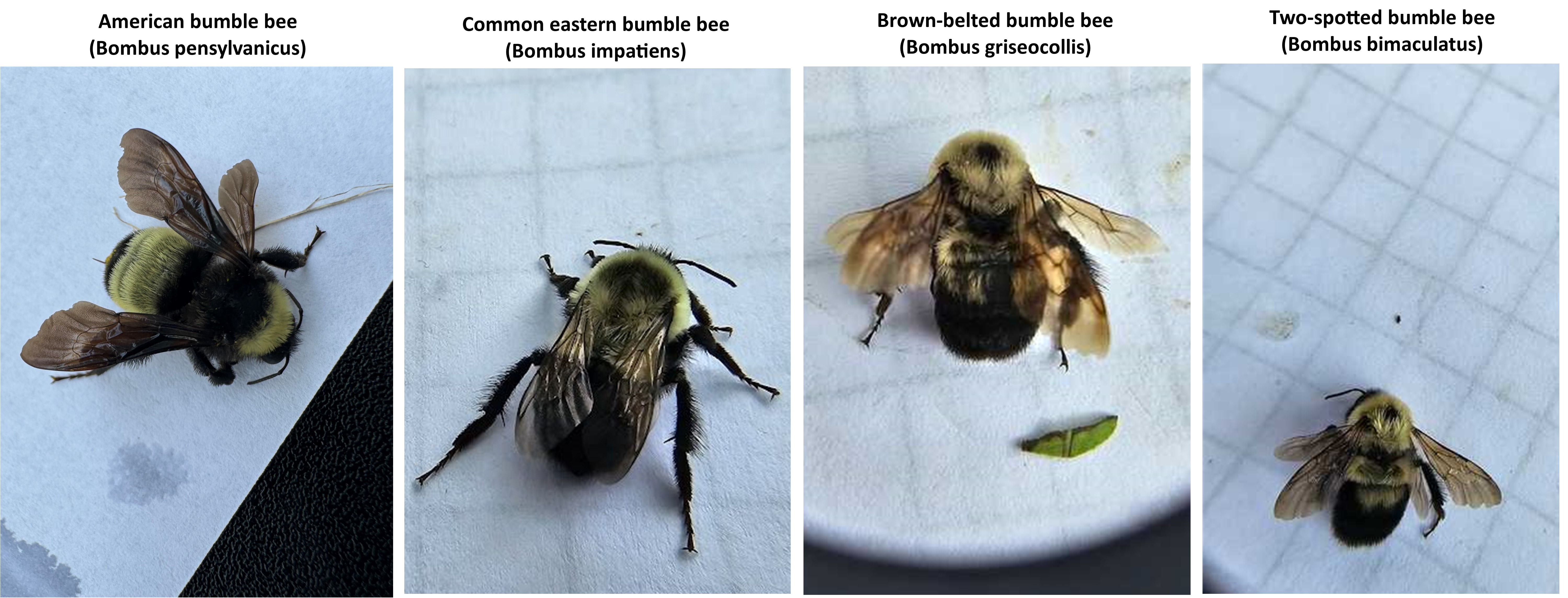August 23, 2024 - SE Atlas Bumble Bee Survey at the Harris Farm
August 23, 2024 @ 10:00AM — 12:00PM Eastern Time (US & Canada) Add to Calendar
Harris Farm (FLC's Office Headquarters): 3402 Andy Harris Road Rockford, TN 37853 Get Directions

Catch the buzz - let's track some bumble bees!
A big thank you to everyone that has assisted Foothills staff with our Summer 2024 SE Atlas Bumble Bee Surveys! We hope you can join us for our last official survey scheduled for Friday, August 23, 2024 from 10AM - 12PM!
Would you like to join Foothills staff for a few hours at the Harris Farm in Rockford, TN, as we complete the last of three bumble bee surveys this summer? This free event will be a great opportunity to explore the Harris Farm, visit our native pollinator meadows, and assist our team for a great cause! FLC staff will be joined by returning bumble bee surveyor and friend of the Conservancy, Katheryn Albrecht, a Certified Wildlife Biologist/Ornithologist with MTM Environmental (https://mtmenvironmentalllc.com/about-us/staff/).
Check out the Maryville Daily Times article about our June bumble bee survey here: Bee in the moment: Citizen scientists study insects at Foothills Land Conservancy
A special thank you! FLC greatly appreciates Oak Ridge Associated Universities
for their support of our August bumble bee survey
and the ongoing support of FLC's regional land conservation programs.
What are the SE Atlas Surveys all about?
The Bumble Bee Atlas (https://www.bumblebeeatlas.org) is a community science project, founded by The Xerces Society, and is aimed at tracking and conserving bumble bees across the U.S. Our region is called the Southeast Atlas and includes the states of TN, GA, NC and SC.
The Southeast Atlas is divided into the above-mentioned states, then those states are divided into grid cells. Once training is completed, volunteers "adopt" a grid cell(s) and conduct surveys within those grid cells during the sampling season (May through end of September).
What's involved and what we will be doing?
The surveys are a little involved, but usually take around 2 hours
to complete (depending on how many bees are captured).
During the survey, bumble bees are safely captured then put into a vial or jar and put on ice in a cooler to be temporarily anesthetized. This allows closer inspection of the bees to properly identify the species and take close-up photos before the bees warm and wake back up. Habitat assessments of the surrounding area are also conducted, and data forms filled out. After each survey, the data and photos are uploaded by a grid cell adopter to the Bumble Bee Watch database where trained professionals review the data and confirm species identifications of each bee entered.
Additional info about the survey itself:
The survey should take around two hours, depending on how many bees we capture. We must survey for a minimum of 45 person minutes, but if we have a few people actively searching then we divide that time by the number of surveyors. Below is a rough outline of the different steps of the survey.
All of the necessary supplies and data forms to complete the survey will be provided but if anybody has an extra butterfly net, they are welcome to bring it along. From doing these surveys Katheryn has learned that it's easier sometimes to just capture the bees directly using the vials. Nets are necessary though for those bees that are out of reach. In general, folks should bring water and sunscreen.
- Set up and go over survey protocol
- Actively survey for bees using butterfly nets and/or directly with vials
- Put captured bees into vials, take photo of bee in vial with host flower
- Put vial with bee in cooler on ice to temporarily anesthetize it.
- Go back to surveying for more bees for remainder of survey time.
- Process bees for photos and species identification (as best we can).
- Fill out habitat assessment part of data form
- Off-site, upload data to Bumble Bee Watch
Want more info? Visit Print Materials | Bumble Bee Atlas and scroll down to the SE Atlas section at the bottom of the page. The section includes a handbook and bee guide.
Your support matters! Several of our survey bumble bee volunteers have provided donations to the Conservancy this summer and we very much appreciate the support. Please consider donating to FLC's regional land conservation programs, which also assists our team with community outreach efforts. A donation button can be found along the right hand side of this page. Thank you!

2024 Bumble Bee survey data submissions to survey site BumbleBeeWatch.org:
July 27, 2024 Survey - 78 bumble bees observed!
- 48 Bombus impatiens (Common eastern)
- 21 Bombus pensylvanicus (American)
- 4 Bombus griseocollis (Brown-belted)
- 2 Bombus bimaculatus (Two-spotted)
- 3 pending observations
June 27, 2924 Survey - 43 bumble bees observed!
- 23 Bombus impatiens (Common eastern)
- 15 Bombus bimaculatus (Two-spotted)
- 4 Bombus griseocollis (Brown-belted)
- 1 bumble bee (species TBD)
Check out the results from our 2023 bumble bee surveys at the Harris Farm (courtesy of Katheryn Albrecht):

